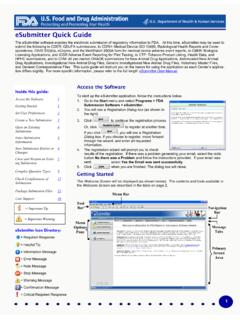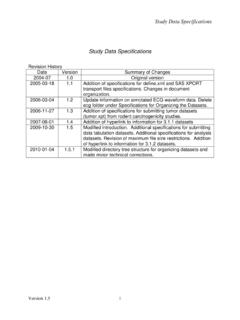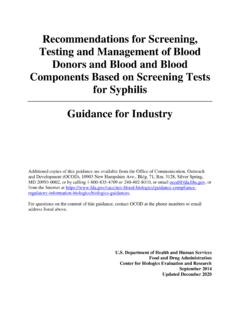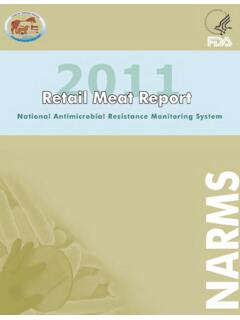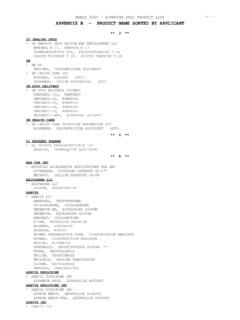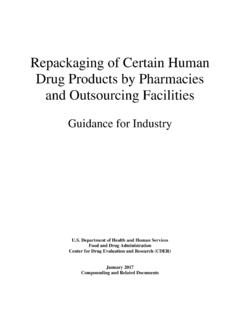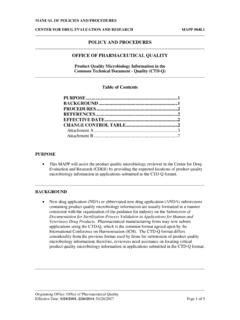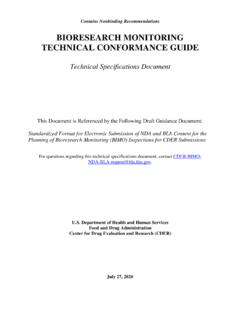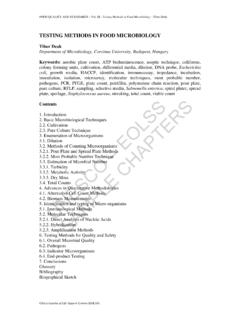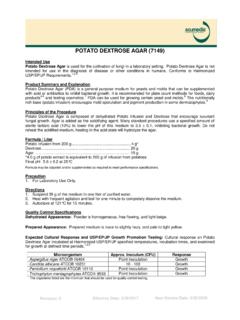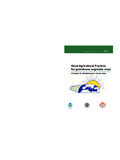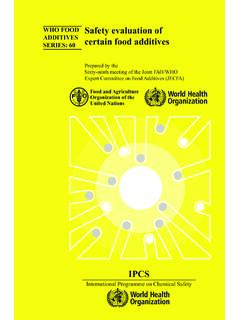Transcription of FDA Retail Food Safety Initiative Action Plan September …
1 FDA Retail food Safety Initiative Action plan September 2011 I. Summary The food and drug administration s (FDA) Retail food Safety Initiative is part of the agency s overall prevention-based, farm-to-table food Safety strategy to reduce foodborne illness. FDA s actions in this Initiative are prompted by its 10-year study of more than 800 Retail food establishments to assess the control of five key foodborne illness risk factors in nine types of Retail operations. FDA s partnerships with the Retail food industry, state, local, and tribal authorities, and other government agencies are fundamental to this Initiative and key to its success. FDA identified four Action areas: 1. Make the presence of certified food protection managers common practice. 2. Strengthen active managerial control at Retail and ensure better compliance. 3. Encourage widespread, uniform, and complete adoption of the FDA food Code. 4. Create an enhanced local regulatory environment for Retail food operations.
2 FDA s Retail food Safety Initiative Action plan outlines activities that FDA will carry out over the next several years. II. Background Foodborne illness is a major cause of personal distress, disease, death, and economic burden. Every year, millions of Americans become sick and many die from foodborne illness, and as a result, the public has become increasingly aware of, and concerned about, the Safety of the food they eat. There are many players in the farm-to-table chain. Each has some degree of responsibility for food Safety . Retail food establishment and foodservice operators have a significant share of the responsibility for ensuring food Safety . Like growers and processors, they have a responsibility to reduce the risk of foodborne illness in their operation. The breadth of the Retail food industry makes it an impossible task for FDA alone to monitor the Safety of food at the Retail level. Retail food Safety efforts are a cooperative and collaborative effort amongst approximately 3,000 state, local, and tribal agencies and the Retail food industry.
3 Page 1 State, local, and tribal agencies are the primary regulators of the Retail food and foodservice industries in the United States. They are responsible for the inspection and oversight of over one million Retail food establishments in restaurants, grocery stores, cafeterias, and vending machines, as well as, food services in health-care facilities, schools, and correctional facilities. FDA strives to promote the application of science-based food Safety principles in Retail and foodservice settings to reduce the incidence of foodborne illness. While state and local agencies have the authority to enforce food Safety regulations, remove unsafe products from store shelves, and bring Action against violators, FDA provides the guidance and training they need to protect food in their jurisdictions.
4 FDA assists regulatory agencies and the Retail food industry by maintaining and updating the food Code, FDA s model regulation for Retail establishments for adoption by state, local, and tribal agencies, providing training; performing evaluations of state programs; and providing technical assistance. FDA works with its regulatory partners to encourage Retail food regulatory agencies to implement the Voluntary National Retail food Regulatory Program Standards, a comprehensive set of standards for state, local, and tribal programs, which provides a framework for program self-assessment and continuous improvement. In October 2010, FDA released the results of its 10-year study tracking the Retail food and foodservice industry s efforts to reduce the occurrence of employee behaviors and practices related to five key foodborne illness risk factors ( food from unsafe sources, poor personal hygiene, inadequate cooking, improper holding of food (time and temperature), and contaminated food surfaces and equipment).
5 ( ) At that time, FDA announced its intention to step up efforts and work closely with state and local governments and operators of Retail food establishments to improve food Safety practices and increase the presence of certified food Safety managers to oversee food Safety practices and prevent illness from contaminated food in Retail food establishments. The data indicate that having a certified food protection manager (CFPM) has a positive impact on food Safety and should become common industry practice. Many states and localities require a CFPM and many in the Retail industry employ them voluntarily as a matter of good practice. The 2004 and 2009 reports revealed a correlation between improved control of certain risk factors and the presence of a CFPM in many of the facility types studied. For instance, the 2009 reports show that overall compliance in full service restaurants was 70 percent with a CFPM, versus 58 percent without a CFPM.
6 In delicatessens, compliance was 79 percent with a CFPM, versus 64 percent without. For seafood markets, compliance with a CFPM was 88 percent, versus 82 percent without. In addition, in produce markets, compliance was 86 percent with a CFPM, versus 79 percent without. Page 2 Overall compliance improved over the three data collection periods in all nine of the establishment types studied. The improvements were statistically significant in elementary schools, fast food restaurants, full-service restaurants, meat and poultry markets and departments, and produce markets and departments. Improvements, although not statistically significant, were also seen in hospitals, nursing homes, deli departments/stores, and seafood departments/stores.
7 However, the study also showed that continued improvements are still needed with regard to three risk factors: poor personal hygiene, improper holding of food , and contaminated food surfaces and equipment. FDA s Retail food Safety Initiative builds on past progress through continued collaboration with the Retail industry and strengthened partnerships with state, local, and tribal agencies in their standard setting and compliance efforts. The goals of FDA s Retail food Safety Initiative are: 1. Make the presence of CFPM common practice. Work with the Conference of food Protection (CFP) to modify the FDA food Code to expand the presence of CFPM. Work with our partners to encourage and facilitate the development of effective training and certification for CFPM in Retail and foodservice establishments. Address the challenges of providing training for a workforce with a high turnover rate and with various educational and cultural backgrounds.
8 2. Strengthen active managerial controls of food Safety at the Retail level to ensure better compliance. Work with our partners to assess the effectiveness of various managerial control strategies. Identify and share best practices. Assess and encourage implementation of regulatory agency initiatives for active managerial control by food establishments. Work with the CFP to consider modifications to the FDA food Code to promote best practices. 3. Encourage widespread, uniform, and complete adoption of the FDA food Code. Work with the Retail food industry and state, local, and tribal authorities to ensure that prevention-oriented, science-based food Safety principles are used at the Retail level. 4. Create an enhanced local regulatory environment for Retail food operations. Promote wider implementation by state, local, and tribal regulatory programs of the FDA Voluntary National Retail food Regulatory Programs Standards.
9 Ensure widespread participation by local regulators in consistent, high quality training through increased access and increased portability and transferability of FDA training courses. Page 3 Seek increased multi-year funding for the state, local, and tribal food Safety programs as part of an integrated food Safety system. III. Action plan This Action plan outlines the steps FDA will take to improve food Safety practices in Retail food establishments. The plan focuses on the key areas where there is room for improvement. Goal 1: Make the presence of certified food protection managers common practice Objective 1: Work with the CFP to modify the FDA food Code to expand the presence of certified food protection managers.
10 Action : To achieve this objective, the following steps are planned: Develop and include a requirement in the Supplement to the 2009 FDA food Code requiring that each food establishment have at least one CFPM. Develop issues for the 2012 biennial meeting of the CFP to discuss removing alternatives from the FDA food Code for the Person-in-Charge being the CFPM. Strengthen industry support through continued collaborations with trade associations and the Retail food industry to make it mandatory to have a CFPM in each food establishment. Objective 2: Work with our partners to encourage and facilitate the development of effective training and certification for CFPMs in Retail and foodservice establishments. Action : To achieve this objective, the following steps are planned: Establish formal partnerships with national Retail and restaurant trade associations, state associations, and other organizations to develop uniform messages, standardized training programs, and promote the development and use of effective training for food workers and certification programs for food protection managers.
